KEP - Trimaran: Real Load Aware Scheduling #
Table of contents #.
- Notes/Constraints/Caveats
- Risks and Mitigations
- Metrics Provider
- Load Watcher/Load Analyser
- Scheduler Plugins
- Score plugin
- Bad Metrics
- Load Watcher API
- Scheduled Pods State
- Scalability
- Troubleshooting
- Implementation History
- Appendix - Load Watcher JSON schema
Minimizing machine costs by utilizing all nodes is the main objective for efficient cluster management. To achieve this goal, we can make the Kubernetes scheduler aware of the gap between resource allocation and actual resource utilization. Taking advantage of the gap may help pack pods more efficiently, while the default scheduler that only considers pod requests and allocable resources on nodes cannot.

Motivation #
Kubernetes provides a declarative resource model that core components (scheduler and kubelet) honor to behave consistently and satisfy QoS guarantees. However, using this model can lead to low-utilization of the cluster for the following reasons:
- It is hard for users to estimate accurate resource usage for applications. Also, users may not understand the resource model and not set it at all.
- The default in-tree scheduling plugins (Score) that Kubernetes provides don’t consider live node utilization values.
This proposal utilizes real time resource usage to schedule pods with proposed plugins. The eventual goal is to increase cluster utilization and decrease costs of cluster management without breaking the contract of Kubernetes Resource Model.
- Provide configurable scheduling plugins to increase cluster utilization.
- Expected CPU Utilisation per node should not go beyond X% (constraint).
- To not affect the behavior of default score plugins unless necessary.
- Implement the above features as Score plugins
Non-Goals #
- Implement the above constraint 2 as Filter plugins.
- Descheduling due to unexpected outcome (hot nodes, fragmentation etc.) of past scoring by plugins is not addressed in the initial design.
- Memory, Network, and Disk utilization are not considered in the initial design.
User Stories #
As a company relying on the public cloud, we would like to minimize machine costs by efficiently utilizing the nodes leased.
As a company-owned data center, we would like to minimize the hardware and maintenance associated with clusters by getting the maximum possible juice out of existing machines.
Increasing resource utilization as much as possible may not be the right solution for all clusters. As it always takes some time to scale up a cluster to handle the sudden spikes of load, cluster admins would like to leave adequate room for the bursty load, so there is enough time to add more nodes to the cluster.
Notes/Constraints/Caveats #
Enabling our plugin(s) will cause conflict with 2 default scoring plugins: “NodeResourcesLeastAllocated” and “NodeResourcesBalancedAllocation” plugins. So it is strongly advised to disable them when enabling plugin(s) mentioned in this proposal. If you choose to enable “NodeResourcesMostAllocated” in tree plugin which is not enabled by default, then it would conflict with our scoring too.
Risks and Mitigations #
If utilization metrics are not available for a long time, we will fall back to the best fit bin pack based on allocations. There is no user action needed for this. To achieve X% utilization, it is recommended to set the value as X - 10 in practice. Refer to TargetLoadPacking Score Plugin below for more details. For more details on risks and mitigations associated with live metrics, refer to “Bad Metrics”.
Design Details #
Our design consists of the following components as outlined in the diagram and described below. We propose two plugins namely “TargetLoadPacking” and “LoadVariationRiskBalancing”. Both of them use metrics from load watcher for scoring nodes with different algorithms.
Metrics Provider #
This service provides metrics backed by a time-series database — for example, Prometheus, InfluxDB, Kubernetes Metrics Server etc.
Load Watcher/Load Analyser #
The load watcher and analyzer both run in a single process. The watcher is responsible for retrieving cluster-wide resource usage metrics like CPU, memory, network, and IO stats over windows of a specified duration from metrics providers above. It stores these in its local cache and persists several aggregations in the host local DB for fault tolerance. The analyzer is responsible for the detection of bad metrics and any remediation. Bad metrics could be due to missing metrics or metrics with considerable errors, making them anomalies. It can also be extended in the future to use ML models for analyzing metrics.
Load watcher would cache metrics in the last 15-minute, 10-minute, and 5-minute windows, which can be queried via REST API exposed. A generic interface will be provided that can support fetching metrics from any metrics provider. Example is provided under Load Watcher API.
This is a localhost database stored as a file. This DB aims to populate the load watcher’s cache quickly if it is lost due to a crash and perform scheduling decisions without any impact on latency. The file will be stored in host file system, so it will be persisted across pod failures on the same node. For HA setups, each load watcher process will maintain its corresponding file locally.
Scheduler Plugins #
This uses the scheduler framework of K8s to incorporate our customized real load aware scheduler plugins without modifying the core scheduler code. The plugins we proposed mainly include the following two.
- TargetLoadPacking Plugin: It is best fit variant of bin pack algorithm that scores nodes by their actual resource utilization in a way that all utilized nodes have around x% of utilization. Once all nodes reach x% utilization it moves to least fit variant.
- LoadVariationRiskBalancing Plugin: It is a node sorting plugin that sorts nodes base on both the mean and the standard deviation of node resource utilization. It aims to balance not only the average load but also the risk caused by load variations.
TargetLoadPacking Plugin #
Score plugin #.
This plugin would extend the Score extension point. K8s scheduler framework calls the Score function for each node separately when scheduling a pod.
Following is the algorithm:
- Get the utilization of the current node to be scored. Call it A.
- Calculate the current pod’s total CPU requests and overhead. Call it B.
- Calculate the expected utilization if the pod is scheduled under this node by adding i.e. U = A + B.
- If U <= X%, return (100 - X)U/X + X as the score
- If X% < U <= 100%, return X(100 - U)/(100 - X)
- If U > 100%, return 0
For example, let’s say we have three nodes X, Y, and Z, with four cores each and utilization 1, 2, and 3 cores respectively. For simplicity, let’s assume our pod to be scheduled has 0 cores CPU requests and overhead. Let X = 50%.
Utilization of each node:
The score of each node :
In the algorithm above, 50% is the target utilization rate we want to achieve on all nodes. We can be less aggressive by reducing it to 40% so that it has much lesser chances of going over 50% during spikes or unexpected loads. So in general to achieve X% utilisation, X - 10 value is recommended in practice.
In the 2nd step of the algorithm, one variant uses the current pod’s total CPU limits instead of requests, to have a stronger upper bound of expected utilization.
The X% threshold value for utilisation will be made configurable via plugin argument.
Algorithm Analysis
The above is a plot of the piecewise function outlined in the algorithm. The key observations here are manifold:
- As the utilization goes from 0 to 50%, we pack pods on those nodes by favoring them.
- The nodes are penalized linearly as the utilization goes beyond 50%, to spread the pod amongst those “hot” nodes.
- The positive slope begins from 50 and not from 0 because the range of score is from 0-100, and we want to maximize our score output for nodes we wish to favor so that the score is more substantial and other plugins do not affect it much.
- There is a break in the graph with a high drop due to the “penalty” we have.
Plugin Config Args
LoadVariationRiskBalancing Plugin #
Balancing load based on average would be risky sometimes, as it does not consider the bursty variations. A LoadVariationRiskBalancing plugin balances not only the average load but also the risk caused by load variations. Suppose we take the mean (M) and standard deviation (V) of all nodes’ utilization into a mu-sigma plot below. In that case, the LoadVariationRiskBalancing plugin will make placements such that all nodes’ utilization are aligned on the diagonal line, which is V + M = c. Here, c is a constant indicating the overall cluster utilization average plus the standard deviation. In summary, considering load on all nodes fluctuates dynamically over time, the LoadVariationRiskBalancing plugin favors nodes with lower risks of the load exceeding capacity.
- Get the requested resource for the pod to be scheduled as, $r$.
- Get the sliding window average $M$ and standard deviation $V$ of resource utilization fraction (range from 0 to 1) for all types of resources (CPU, Memory, GPU, etc.) of the current node to be scored.
- Calculate the score of the current node for each type of resource: $S_i = M + r + V$
- Get a score for each type of resource and bound it to [0,1]: $S_i = min(S_i, 1.0)$
- Calculate the node priority score per resource as: $U_i = (1 - S_i) \times MaxPriority$
- Get the final node score as: $U = min(U_i)$
For example, let’s say we have three nodes N1 , N2 , and N3 , and the pod to be scheduled have CPU and Memory requests as 500 milicores and 1 GB. All nodes have a capacity of 4 cores and 8 GB.
The pod request fraction can be computed as $r_{cpu} = \frac{1}{8}, r_{memory} = \frac{1}{8}$.
Then according to steps 2 ~ 4, the mean and standard deviation of CPU and memory fraction utilization can be computed as follows:
The score for each type of resource and each node are as follows according to step 5 ~ 6:
According to the scores we have, node N3 will be selected. The utilization fraction of nodes before and after the placement is as follows.
If we plot these in mu-sigma plots, we can see the placement automatically pushes the utilization of nodes toward the diagonal line sigma = 1 - mu. The 1 here indicates 100% of utilization. What can be configured is a coefficient ita , which indicates mu + ita x sigma <= 100 % and we choose ita = 1 here. ita here models the confidence of usage not exceeding the node capacity under the assumption that the actual usage follows Gaussian distribution and follows the 68-96-99.5 rule .
So when ita gets different values, we get different confidence of not exceeding the capacity.
- ita = 1 , we have a 16% risk that the actual usage exceeds the node capacity.
- ita = 2 , we have a 2.5% chance that the actual usage exceeds the node capacity.
- ita = 3 , we have a 0.15% chance that the actual usage exceeds the node capacity. By default, we choose ita = 1 as we would like to improve the overall utilization. ita can be configured via the SafeVarianceMargin for the plugin.
Bad Metrics #
Since load watcher is a major component needed by the plugin to find out utilization values, metrics are essential for the plugin’s correctness. Bad metrics can be due to several issues. A few of them being are given below, along with their remediation. Detection of bad metrics is a problem in its own, other than its remediation.
- Short inter-arrival times of pods: In this case, we predict utilization for the recent pods that got scheduled on the node based on its request values and a multiplier, and add it to the current utilization. If the pods belong to best-effort QoS, i.e. don’t have requests, we assume a number like 1 milicore which is configurable.
- Failure of Metric reporting agent running in node: In this case, the metrics would be missing for a particular time. We can use the latest available utilization window (not older than 5 minutes) along with predicted utilization of pods scheduled on that node after the window end time. If this is not available we avoid the node by scoring it minimum.
- Metrics Provider failure: The metrics provider can fail to serve requests for several reasons like OOM, unresponsive components, etc. In this case, every node’s metrics are unavailable, and we fall back to the best fit based on allocations. However, we do not plan to target the fall back in first implementation.
- Addition of new nodes: It is easy to handle this if no pods have been scheduled on them, so utilization must be 0. If any recent new pods are running already then we can use the method above for prediction. If there are long-running pods, we can avoid this node until metrics are available.
- Incorrect metrics (due to misconfiguration, bugs, etc.): It is challenging to detect such metrics. For the first implementation, we would like to ignore this case by assuming metrics are correct. However, we plan to add metrics from multiple providers to corroborate data points and minimize the effect of incorrect metrics on scheduling in the future.
Load Watcher API #
JSON Schema - see Appendix
JSON payload example:
Scheduled Pods State #
A controller will be added as a go routine watching events on .spec.nodeName . This will maintain a time ordered state of node → pod mappings for pods scheduled successfully in last 5 minutes. This state will be maintained across scheduling cycles and used from TargetLoadPacking/LoadVariationRiskBalancing Score plugin. It will help to predict utilisation based on allocations when metrics are bad, especially in case 1 above (Unavailability of metrics).
Test Plan #
Unit tests and Integration tests will be added.
Production Readiness Review Questionnaire #
Scalability #.
Will enabling / using this feature result in any new API calls?
Will enabling / using this feature result in introducing new API types?
Will enabling / using this feature result in any new calls to the cloud provider?
Will enabling / using this feature result in increasing size or count of the existing API objects?
Will enabling / using this feature result in increasing time taken by any operations covered by existing SLIs/SLOs ?
It can affect scheduler latency, however since 2 plugins need to be disabled the overall latency would be likely lesser than before. This will be confirmed with some benchmarking.
Will enabling / using this feature result in non-negligible increase of resource usage (CPU, RAM, disk, IO, …) in any components?
No - the metrics are cached at load watcher and our plugins will only pull them when needed, and this shouldn’t be a non-negligible increase in resource usage. Moreover, the algorithms provided run in linear time for number of nodes.
Troubleshooting #
How does this feature react if the API server and/or etcd is unavailable?
Running pods are not affected. Any new submissions would be rejected by scheduler.
What are other known failure modes?
What steps should be taken if SLOs are not being met to determine the problem?
Implementation History #
Load watcher json schema #.
Trimaran: Load-Aware Scheduling for Power Efficiency and Performance Stability
If you're experiencing a cluster where some nodes are stubbornly congested and others are not, or some nodes are spiky in their utilization, or some pods are able to burst freely yet others are not, then you may need to use a Trimaran scheduler. In this talk, we will provide an overview of the Trimaran scheduler plugins and demonstrate their utility. Basically, Trimaran plugins are load-aware schedulers which place pods on nodes based on actual measured node resource utilization, while considering requests and limits specifications of resources. Having utilization as an objective helps (1) minimize power consumption by targeting an optimal range of utilization, (2) avoid congestion and interference among multiple containers running on the same node, and (3) lower the risk of overcommitment when containers burst their usage to the specified limits.
Publication
- Asser Tantawi
- Hybrid Cloud Platform
- Distributed Systems
- Open Source
Regression with Sensor Data Containing Incomplete Observations
Intelligent adaptation of hardware knobs for improving performance and power consumption, cluster system management.
This package is not in the latest version of its module.
Trimaran: Load-aware scheduling plugins
Trimaran is a collection of load-aware scheduler plugins described in Trimaran: Real Load Aware Scheduling .
Currently, the collection consists of the following plugins.
- TargetLoadPacking : Implements a packing policy up to a configured CPU utilization, then switches to a spreading policy among the hot nodes. (Supports CPU resource.)
- LoadVariationRiskBalancing : Equalizes the risk, defined as a combined measure of average utilization and variation in utilization, among nodes. (Supports CPU and memory resources.)
The Trimaran plugins utilize a load-watcher to access resource utilization data via metrics providers. Currently, the load-watcher supports three metrics providers: Kubernetes Metrics Server , Prometheus Server , and SignalFx .
There are two modes for a Trimaran plugin to use the load-watcher : as a service or as a library.
load-watcher as a service
In this mode, the Trimaran plugin uses a deployed load-watcher service in the cluster as depicted in the figure below. A watcherAddress configuration parameter is required to define the load-watcher service endpoint. For example,
Instructions on how to build and deploy the load-watcher can be found here . The load-watcher service may also be deployed in the same scheduler pod, following the tutorial here .

load-watcher as a library
In this mode, the Trimaran plugin embeds the load-watcher as a library, which in turn accesses the configured metrics provider. In this case, we have three configuration parameters: metricProvider.type , metricProvider.address and metricProvider.token .

The configuration parameters should be set as follows.
- KubernetesMetricsServer (default)
- http://prometheus-k8s.monitoring.svc.cluster.local:9090
- metricProvider.token : set only if an authentication token is needed to access the metrics provider.
The selection of the load-watcher mode is based on the existence of a watcherAddress parameter. If it is set, then the load-watcher is in the 'as a service' mode, otherwise it is in the 'as a library' mode.
In addition to the above configuration parameters, the Trimaran plugin may have its own specific parameters.
Following is an example scheduler configuration.
A note on multiple plugins
The Trimaran plugins have different, potentially conflicting, objectives. Thus, it is recommended not to enable them concurrently. As such, they are designed to each have its own load-watcher.
Documentation ¶
- type PodAssignEventHandler
- func New() *PodAssignEventHandler
- func (p *PodAssignEventHandler) OnAdd(obj interface{})
- func (p *PodAssignEventHandler) OnDelete(obj interface{})
- func (p *PodAssignEventHandler) OnUpdate(oldObj, newObj interface{})
Constants ¶
This section is empty.
Variables ¶
Functions ¶, type podassigneventhandler ¶.
This event handler watches assigned Pod and caches them locally
Returns a new instance of PodAssignEventHandler, after starting a background go routine for cache cleanup
func (*PodAssignEventHandler) OnAdd ¶
Func (*podassigneventhandler) ondelete ¶, func (*podassigneventhandler) onupdate ¶, source files ¶, directories ¶.
| Path | Synopsis |
|---|---|
| Package loadvariationriskbalancing plugin attempts to balance the risk in load variation across the cluster. | |
Keyboard shortcuts
| : This menu | |
| : Search site | |
| or | : Jump to |
| or | : Canonical URL |
Platform products
- Red Hat Enterprise Linux A flexible, stable operating system to support hybrid cloud innovation.
- Red Hat OpenShift A container platform to build, modernize, and deploy applications at scale.
- Red Hat Ansible Automation Platform A foundation for implementing enterprise-wide automation.
- Start a trial Assess a product with a no-cost trial.
- Buy online Buy select products and services in the Red Hat Store.

- Red Hat Enterprise Linux AI New
- Red Hat OpenShift AI
- Red Hat OpenShift Virtualization
- Red Hat OpenShift Service on AWS
- Microsoft Azure Red Hat OpenShift
- Application platform Simplify the way you build, deploy, manage, and secure apps across the hybrid cloud.
- Artificial intelligence Build, deploy, and monitor AI models and apps with Red Hat's open source platforms.
- Edge computing Deploy workloads closer to the source with security-focused edge technology.
- IT automation Unite disparate tech, teams, and environments with 1 comprehensive automation platform.
- Linux standardization Get consistency across operating environments with an open, flexible infrastructure.
- Security Deliver software using trusted platforms and real-time security scanning and remediation.
- Virtualization Modernize operations using a single platform for virtualized and containerized workloads.
By industry
- Financial services
- Industrial sector
- Media and entertainment
- Public sector
- Telecommunications
- Open Innovation Labs
- Technical Account Management
Training & certification
- All courses and exams
- All certifications
- Verify a certification
- Skills assessment
- Learning subscription
- Learning community
- Red Hat Academy
- Connect with learning experts
- Ansible Basics: Automation Technical Overview (No cost)
- Containers, Kubernetes and Red Hat OpenShift Technical Overview (No cost)
- Red Hat Enterprise Linux Technical Overview (No cost)
- Red Hat Certified System Administrator exam
- Red Hat System Administration I
- Application modernization
- Cloud computing
- Cloud-native applications
Edge computing
- Virtualization
- See all topics
- What is InstructLab? New
- What are cloud services?
- What is edge computing?
- What is hybrid cloud?
- Why build a Red Hat cloud?
- Cloud vs. edge
- Red Hat OpenShift vs. Kubernetes
- Learning Ansible basics
- What is Linux?
More to explore
- Customer success stories
- Events and webinars
- Podcasts and video series
- Documentation
- Resource library
- Training and certification
For customers
- Our partners
- Red Hat Ecosystem Catalog
- Find a partner
For partners
- Partner Connect
- Become a partner
- Access the partner portal
- Our company
- How we work
- Our social impact
- Development model
- Subscription model
- Product support
Open source
- Open source commitments
- How we contribute
- Red Hat on GitHub
Company details
- Analyst relations
Recommendations
As you browse redhat.com, we'll recommend resources you may like. For now, try these.
- All Red Hat products
- Tech topics
- Red Hat resources
Select a language
- Training & services
- Red Hat Enterprise Linux
- Red Hat OpenShift
- Red Hat Ansible Automation Platform
Applications
- Cloud services
Infrastructure
Open hybrid cloud, original shows, how to bring your own scheduler into openshift with the secondary scheduler operator.
- Back to all posts
To understand the Secondary Scheduler Operator, we need to understand the Kubernetes scheduler. The Kubernetes scheduler is an enterprise grade stable component in Kubernetes that decides where to place the incoming pods by a two step operation of filtering and scoring. The Kubernetes scheduler works well for applications that need to schedule pods in a sequence, for example a web application. Now the customer sees the benefits of Kubernetes, like DevOps and portability. They want to transform their specialized workload like HPC, Telco into containers and run it in Kubernetes. The default scheduler that works well for web servers does not work well for these specialized applications because these applications have special needs from the scheduler. For example:
- Coscheduling : Start, execute and finish all pods at same time.
- Topology Aware Scheduler : Schedule pods based on node topology.
- Load Aware Scheduler : Schedule pods based on load of the nodes.
So there is a need for new schedulers to run specialized workloads.
OpenShift is Red Hat’s enterprise Kubernetes distribution. This means OpenShift has the same scheduler as upstream Kubernetes, which is stable and enterprise grade but best suited for applications that need to schedule pods in a sequence. We in Red hat always listen to our customers and partners that there is a need to bring in their own scheduler, which can best run their application.
The Secondary Scheduler Operator allows customers or partners to bring in their own scheduler in OpenShift and run their application with that customized scheduler.OpenShift 4.x has been re-architected to be a self hosted platform which uses the same OpenShift constructs that any workload running on OpenShift uses. In order to safeguard the control components from the custom scheduler that the end user (customer) can bring in, we decided to have a secondary scheduler which does not have any impact on the control plane components.
Architecturally the default scheduler is responsible for schedu ling all the workloads including control plane components; however if the customer chooses to bring their own scheduler, they can leverage secondary scheduler operator to manage the workloads of their choice but the control plane components would still use the default scheduler shipped with OpenShift.
The following diagram explains the overall flow of how to add your scheduler as payload via the Secondary Scheduler Operator provided by Red Hat.

There is a separation of responsibility when a customer installs their own scheduler via this operator. Customers are responsible for maintaining their custom scheduler and Red Hat is responsible for the operator.

In this example we will walk you through how easy it is to install the Load aware scheduling plugin via the Secondary Scheduler Operator.
Step 1: Install the Secondary Scheduler Operator
- Create a namespace openshift-secondary-scheduler-operator to install the Secondary Scheduler Operator first.
- Open the OperatorHub console to search for the Secondary Scheduler Operator.
- Click on Install to install the Secondary Scheduler Operator.
- Choose the project namespace as openshift-secondary-scheduler-operator .
- Now the operator is ready to use.

Step 2: Configure the Secondary Scheduler Operator to install Trimaran scheduler as a secondary scheduler
- Create a config.yaml to define KubeSchedulerConfiguration for the Trimaran scheduler that runs TargetLoadPacking plugin. The schedulerName should be set as secondary-scheduler .
- Run the following commands to obtain the ${PROM_URL} and ${PROM_TOKEN} , and replace these with the real Prometheus endpoint and token in config.yaml .
- Create a ConfigMap secondary-scheduler-config for the Trimaran KubeSchedulerConfiguration under the openshift-secondary-scheduler-operator namespace .
- Click on Create SecondaryScheduler to create an instance of SecondaryScheduler and configure the SecondaryScheduler YAML accordingly.
- Configure the schedulerConfig to point to the secondary-scheduler-config ConfigMap.
- Configure the schedulerImage to the default scheduler-plugin image that includes Trimaran plugins.
- Then click Create to install a secondary scheduler instance that runs the Trimaran scheduler.
- Finally, the operator will install a secondary-scheduler deployment running under openshift-secondary-scheduler-operator namespace. Check the logs to verify if the Trimaran scheduler is successfully running.

- GitHub link
- Documentation
- Red hat Support
- Red Hat Sales
About the authors
Gaurav singh, jan chaloupka, more like this, deployment considerations for red hat openshift confidential containers solution, save, edit, and share blueprints in insights image builder, cloud native sustainability with kepler | technically speaking, kubernetes and the quest for a control plane | technically speaking, browse by channel.
The latest on IT automation for tech, teams, and environments
Artificial intelligence
Updates on the platforms that free customers to run AI workloads anywhere
Explore how we build a more flexible future with hybrid cloud
The latest on how we reduce risks across environments and technologies
Updates on the platforms that simplify operations at the edge
The latest on the world’s leading enterprise Linux platform
Inside our solutions to the toughest application challenges
Entertaining stories from the makers and leaders in enterprise tech
- See all products
- Customer support
- Developer resources
- Red Hat value calculator
Try, buy, & sell
- Product trial center
- Red Hat Marketplace
- Red Hat Store
- Buy online (Japan)
Communicate
- Contact sales
- Contact customer service
- Contact training
- About Red Hat
We’re the world’s leading provider of enterprise open source solutions—including Linux, cloud, container, and Kubernetes. We deliver hardened solutions that make it easier for enterprises to work across platforms and environments, from the core datacenter to the network edge.
Red Hat legal and privacy links
- Contact Red Hat
- Red Hat Blog
- Diversity, equity, and inclusion
- Cool Stuff Store
- Red Hat Summit
- Privacy statement
- Terms of use
- All policies and guidelines
- Digital accessibility
Select Your Language
Install the secondary scheduler operator and deploy the trimaran scheduler.
- No translations currently exist.
- How to install the Secondary Scheduler Operator and deploy the loadaware Trimaran scheduler image
- There is a separation of responsibility when a customer installs their own scheduler via this operator.
- Customers are responsible for maintaining their custom scheduler and Red Hat is responsible for the operator.
- This example uses the loadaware Trimaran scheduler image, which Red Hat does not support

Environment
Subscriber exclusive content.
A Red Hat subscription provides unlimited access to our knowledgebase, tools, and much more.
Current Customers and Partners
Log in for full access
New to Red Hat?
Learn more about Red Hat subscriptions
Using a Red Hat product through a public cloud?
How to access this content
Quick Links
- Subscriptions
- Support Cases
- Customer Service
- Product Documentation
- Contact Customer Portal
- Customer Portal FAQ
- Log-in Assistance
- Trust Red Hat
- Browser Support Policy
- Accessibility
- Awards and Recognition
Related Sites
- developers.redhat.com
- connect.redhat.com
- cloud.redhat.com
Systems Status
- Red Hat Subscription Value
- About Red Hat
- Red Hat Jobs
Red Hat legal and privacy links
- Contact Red Hat
- Red Hat Blog
- Diversity, equity, and inclusion
- Cool Stuff Store
- Red Hat Summit
- Privacy statement
- Terms of use
- All policies and guidelines
- Digital accessibility
Formatting Tips
Here are the common uses of Markdown.
Request a English Translation
Generating machine translation.
Santosh Abraham is a Member of the Technical Staff at Hewlett Packard Laboratories. Prior to joining HP Labs, Santosh taught at the University of Michigan, Ann Arbor. Santosh co-authored over 40 papers in multiprocessor systems, optimizing compilers, performance evaluation, memory hierarchy simulation and design. Santosh co-developed the widely used Cheetah cache simulator. Santosh received a B.Tech degree from the Indian Institute of Technology, Bombay, M.S. from the State University of New York, Stony Brook, and Ph.D. from the University of Illinois, Urbana, all in Electrical Engineering. Memory structures of custom embedded systems contain buffer memories and local memories, in lieu of conventional caches. Santosh's current research is in automating the design and compilation for such memory structures. Santosh was the primary designer and implementer of the Trimaran scheduler. The Trimaran scheduler supports meld scheduling and a variety of scheduling algorithms, including back-tracking. Santosh also developed a module to utilize memory dependence profiling information. Within Elcor, Santosh designed a module that reduces cache stalls by increasing the scheduling distance between loads that are likely to miss and their uses. Santosh co-designed a module to utilize effectively the local memory ports in architectures that have a local memory in addition to a conventional memory hierarchy. In the overall Pico framework, Santosh designed and implemented the Memory Spacewalker that automatically and efficiently evaluates a specified range of memory hierarchies using the Cheetah simulator and produces paretos for each level of the memory hierarchy as well as for the overall system.
- - K-town Now
- Asia-Pacific
- - Storm Tracker
- Middle East
- Map of Memorials
- Entertainment
- - Video Games
- Europe Travel
- - Quick Trips
- - After Hours
- Pacific Travel
- The Meat and Potatoes of Life
- U.S. Travel
- Storm Tracker
- Rewards for readers
- Get Stripes
- Stripes Lite
- Archives/Library
- Special Publications
- Mobile Apps
- Email Newsletters
- Digital Access
- Home Delivery
- Marine Corps
- Coast Guard
- Space Force
- Archive photo of the day
- - Schedules Europe
- - Scoreboards Europe
- - Schedules Pacific
- - Scoreboards Pacific
- - Pacific Sports Blog
- - WW II Podcast
- - Military Matters
- - Force for Hire
- Out of Uniform
- - WW II Videos
- Communities
- Stripes Europe
- Stripes Guam
- Stripes Japan
- Stripes Korea
- Stripes Okinawa
- Our Other Websites
- In Memoriam
- Month of the Military Child
- Best of Germany
- Best of the Pacific
- Letters to Santa
Navy christens USS Kingsville, one of the last Independence-class littoral combat ships
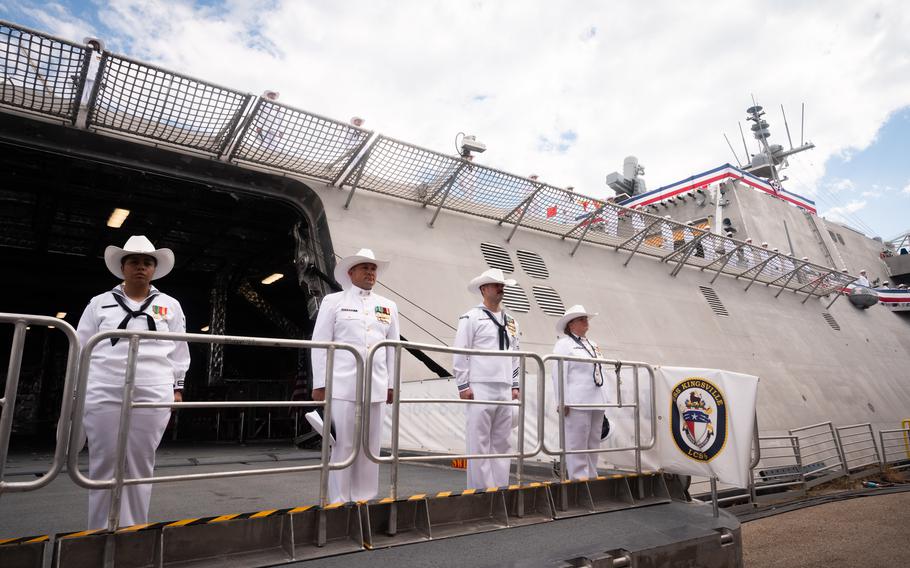
The crew of the Navy’s newest littoral combat ship, USS Kingsville (LCS 25), brings the ship to life during its commissioning ceremony Saturday, Aug. 24, 2024, in Corpus Christi, Texas. (Nicholas V. Huynh/U.S. Navy)
The USS Kingsville, one of the last Independence-class littoral combat ships built for the Navy, was christened Saturday in Corpus Christi, Texas .
Cmdr. Ludwig Mann III, Kingsville’s commanding officer, reported the ship manned and ready, and the ship sponsor, gave the traditional order to “Man our ship and bring her to life!” T-45C aircraft assigned to Training Squadron 21 at Naval Air Station Kingsville flew overhead as the crew ran aboard the ship.
Assistant Secretary of the Navy for Financial Management and Comptroller, Russell Rumbaugh, delivered the commissioning ceremony’s principal address. The ceremony also featured remarks from Vice Adm. Brad Skillman, the Deputy Chief of Naval Operations for Integration and Capabilities and Resources; U.S. Reps Vicente Gonzalez Jr. and Michael Cloud; Kingsville Mayor Sam Fugate; and Corpus Christie Mayor Paulette Guajardo.
“This experience is a unique one and should be cherished. You will create a culture that I am sure will last as the Kingsville way for decades to come,” Skillman said. “... I also know you and the crew are ready to get out there and do the Navy’s and the nation’s business around the globe. Tough and confident, go get them.”
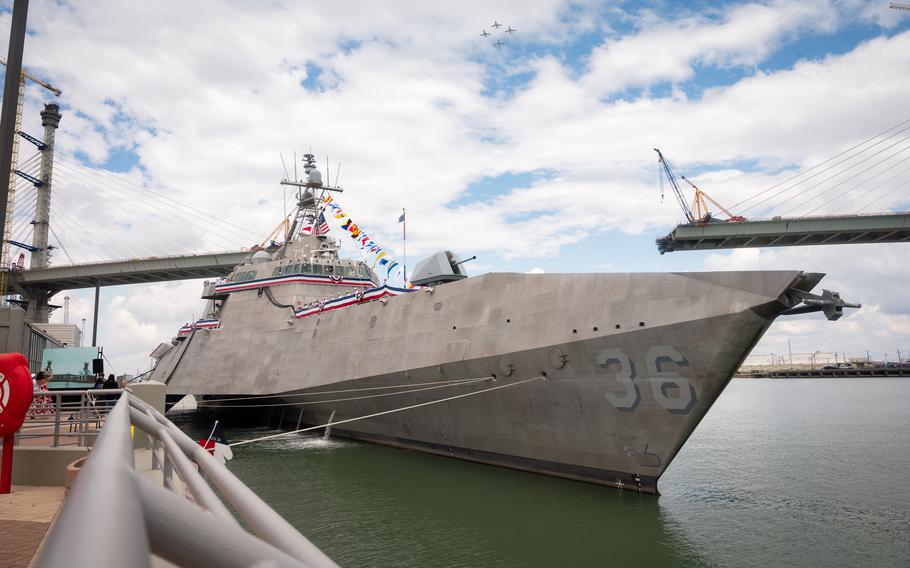
Audience members observe the commissioning ceremony of the Navy’s newest littoral combat ship, USS Kingsville (LCS 36), on Saturday, Aug. 24, 2024, in Corpus Christi, Texas. (Nicholas V. Huynh/U.S. Navy)

Assistant Secretary of the Navy Russel Rumbaugh gives remarks during the commissioning ceremony of the Navy’s newest littoral combat ship, USS Kingsville (LCS 36), on Saturday, Aug. 24, 2024, in Corpus Christi, Texas. (Nicholas V. Huynh/U.S. Navy)
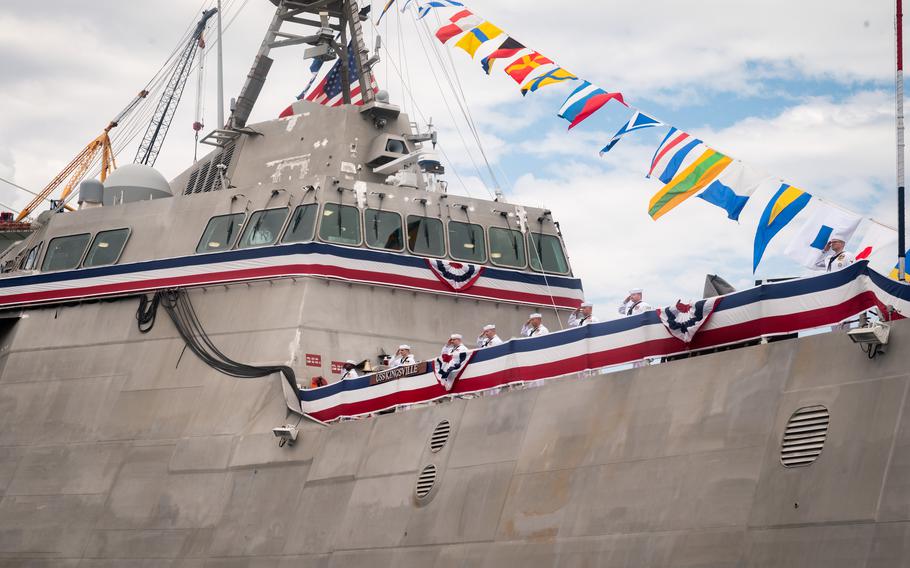
Kingsville, the 18th Independence-variant LCS, is the first to bear the name and pays homage to the city of Kingsville and the King Ranch. The ship’s sponsor is a member of the sixth generation of the King Ranch family, descendants of steamboat captain Richard King, who founded the King Ranch in Kingsville in 1853. The King Ranch continues to foster a relationship with Naval Air Station Kingsville, which was founded in 1942 and is located three miles from the city’s center.
The Kingsville is a 422-foot aluminum-hull trimaran that is designed to operate in shallow, near-shore waters, primarily to identify and neutralize mines and to conduct maritime security, according to the Navy. Independence-class LCS are capable of traveling nearly 50 mph in ideal sea conditions, making them among the fastest vessels in the Navy.
The ships integrate with joint combined, manned and unmanned teams to support forward presence, maritime security, sea control and deterrence missions around the globe.
Many LCS will be replaced by the new Constellation-class frigates now under development by the Navy. The first of those vessels won’t be ready until at least 2027.
USS Kingsville will homeport in San Diego.
Contributing: The San Diego Union-Tribune.
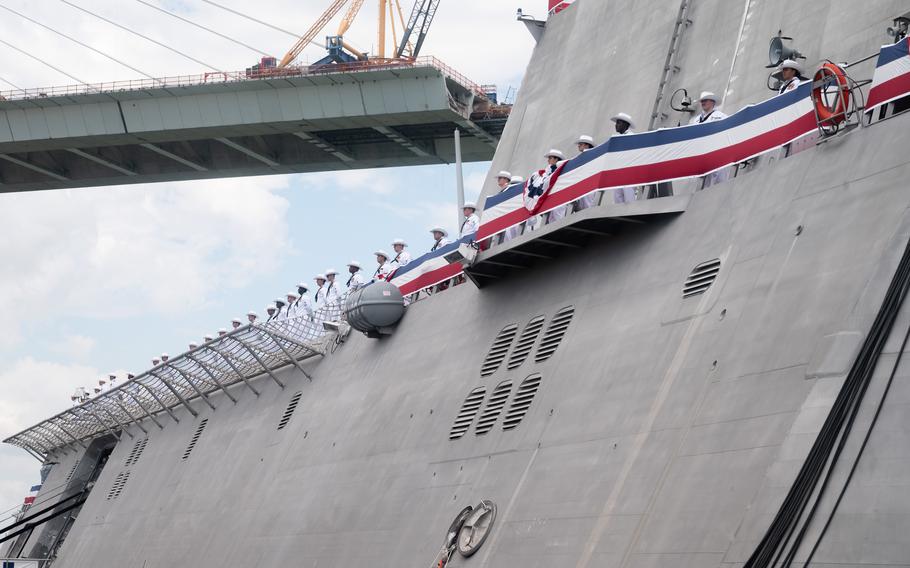
Sign Up for Daily Headlines
Sign up to receive a daily email of today's top military news stories from Stars and Stripes and top news outlets from around the world.
Sign Up Now

Times of San Diego
Local News and Opinion for San Diego
Navy Commissions Another Littoral Combat Ship Headed to San Diego

Share this:
- Click to share on Twitter (Opens in new window)
- Click to share on Facebook (Opens in new window)
- Click to share on Reddit (Opens in new window)
- Click to share on Pinterest (Opens in new window)
- Click to email a link to a friend (Opens in new window)
- Click to print (Opens in new window)

The U.S. Navy commissioned Independence-variant littoral combat ship USS Kingsville — LCS 36 — at the Solomon P. Ortiz Center in Corpus Christi, Texas, on Saturday.
The ship’s homeport will be Naval Base San Diego , where all Navy trimaran variants of the littoral class are based.
Russell Rumbaugh, assistant secretary of the Navy, delivered the commissioning ceremony’s principal address.
“A ship commissioning is one of the ways the U.S. Navy keeps itself tied to the nation it serves,” said Rumbaugh. “And what better moment to celebrate our long and intimate relationship than commissioning a ship named after Kingsville. We in the Department of the Navy are proud of the littoral combat ships.”
The night before commissioning, the Kingsville Commissioning Committee held a reception onboard the USS Lexington Museum where the crew of Kingsville was recognized for their service and dedication.
Kingsville is the first to bear this name and pays homage to the city of Kingsville, Texas, the location of a naval air station, and the King Ranch. The ship’s sponsor is a member of the sixth generation of the King Ranch family, descendants of steamboat captain Richard King, who founded the ranch in 1853.
Independence-variant littoral combat ships integrate with joint combined, manned and unmanned teams to support forward presence, maritime security, sea control, and deterrence missions worldwide. Kingsville is the 18th Independence-variant LCS.

- Visit Our Blog about Russia to know more about Russian sights, history
- Check out our Russian cities and regions guides
- Follow us on Twitter and Facebook to better understand Russia
- Info about getting Russian visa , the main airports , how to rent an apartment
- Our Expert answers your questions about Russia, some tips about sending flowers

Russian regions
- Amur oblast
- Buryat republic
- Chukotka okrug
- Jewish autonomous oblast
- Kamchatka krai
- Khabarovsk krai
- Magadan oblast
- Primorye krai
- Sakha republic
- Sakhalin oblast
- Zabaikalsky krai
- Map of Russia
- All cities and regions
- Blog about Russia
- News from Russia
- How to get a visa
- Flights to Russia
- Russian hotels
- Renting apartments
- Russian currency
- FIFA World Cup 2018
- Submit an article
- Flowers to Russia
- Ask our Expert
Yuzhno-Sakhalinsk city, Russia
The capital city of Sakhalin oblast .
Yuzhno-Sakhalinsk - Overview
Yuzhno-Sakhalinsk is a city located in the southern part of Sakhalin Island in the Far East of Russia, the administrative center of Sakhalin Oblast.
The population of Yuzhno-Sakhalinsk is about 201,700 (2022), the area - 164 sq. km.
The phone code - +7 4242, the postal codes - 693000-693904.
Yuzhno-Sakhalinsk city flag
Yuzhno-sakhalinsk city coat of arms.

Yuzhno-Sakhalinsk city map, Russia
Yuzhno-sakhalinsk city latest news and posts from our blog:.
29 October, 2019 / Yuzhno-Sakhalinsk - the view from above .
History of Yuzhno-Sakhalinsk
Foundation of yuzhno-sakhalinsk.
The Russians first visited Sakhalin Island in 1742. In 1805, the Russian-American Company sent Adam Johann von Krusenstern, a Russian admiral and explorer, to Sakhalin to hoist the Russian flag on the island. Officially, neither Russia nor Japan claimed Sakhalin and the Kuril Islands. In 1855, a treatise on friendship and the border was signed in Shimoda, which marked the beginning of diplomatic relations between Russia and Japan. According to it, Sakhalin remained jointly owned by the two countries.
The settlement of Sakhalin by Russians was mainly due to exiled convicts. In 1869, Sakhalin was officially declared a place of exile and hard labor. In 1875, the St. Petersburg Treaty was signed between the Russian Empire and Japan, according to which Sakhalin completely went to Russia and the Kuril Islands - to Japan.
In 1881, according to the order of the military governor of the Primorsky region, Major Vladimir Yantsevich was appointed head of exiles in South Sakhalin. He received the following instructions: “For the settlement of those who are finishing their terms of hard labor, a place that is quite convenient for arable farming should be chosen. The selected site, if possible along the main road from south to north, should be planned, divided into sections and, as a new settlement, named by some permanent name.”
In 1883, Yantsevich applied for the approval of the names of four new villages founded in the south of Sakhalin: Solovyovskoe, Mitsulskoe, Vladimirovka (future Yuzhno-Sakhalinsk), and Vlasovskoe. In 1885, 57 people lived in Vladimirovka, in 1895 - 130 people. In 1897, there were 150 residential and commercial buildings here: a church, a school, a post office, a hospital, a mill, trade shops, a number of government buildings, and a lot of residential log houses.
More historical facts…
Japanese period in the history of Yuzhno-Sakhalinsk
In 1905, after the defeat of the Russian Empire in the Russo-Japanese War, according to the Treaty of Portsmouth, part of Sakhalin south of the 50th parallel was ceded to the Japanese Empire and became the Karafuto Prefecture. The northern part of Sakhalin remained under the control of the Russian Empire.
In 1908, Vladimirovka was renamed Toyohara (“bountiful plain”). In 1915, the settlement received the status of a town. The Japanese made their own plan for the development of the town with a clear rectangular planning system with the direction of streets along the railway and perpendicular to it.
The building density was high, as a result, a significant number of residential buildings were without outbuildings, sheds and other ancillary buildings, as well as yards. On the outskirts of the town there was a well-maintained park with an artificial reservoir. In 1920, the population of Toyohara was 14,176 people, in 1935 - 28,459.
On February 11, 1945, Stalin, Roosevelt and Churchill signed an agreement in Yalta on the conditions for the USSR’s entry into the war against Japan. Among the conditions were the return of South Sakhalin to the USSR and the annexation of the Kuril Islands. In August 1945, Soviet troops entered Toyohara.
This is what Toyohara looked like from the words of Dmitry Kryukov, head of the civil administration of South Sakhalin and the Kuril Islands, who arrived in the town in September 1945: “The town mainly consists of wooden buildings. The houses are adjacent to each other, timber-frame, plastered. Many of them look good, but they are cold.” The majority of the population were Japanese and Koreans.
Yuzhno-Sakhalinsk - the capital of Sakhalin Oblast
On February 2, 1946, Yuzhno-Sakhalin Oblast was formed on the territory of South Sakhalin and the Kuril Islands. On June 4, 1946, Toyohara became its administrative center. It was renamed Yuzhno-Sakhalinsk (“South Sakhalin City”).
On January 2, 1947, Yuzhno-Sakhalin Oblast was liquidated and its territory was included in Sakhalin Oblast, a separate region of the Russian Soviet Federative Socialist Republic. On April 18, 1947, Yuzhno-Sakhalinsk became its administrative center.
In the spring of 1947, the mass repatriation of the Japanese began. By August 1, 1947, 124,308 people left Sakhalin, almost half of the local Japanese. During 1947-1949, about 400 thousand people were brought to Sakhalin from the central regions of Russia, Primorye and the Far East. By 1949, only 2,682 Japanese remained on Sakhalin - those who managed to obtain a Soviet passport. The Koreans from Sakhalin were not forcibly evicted, so most of them stayed. In 1959, the population of Yuzhno-Sakhalinsk was 85,510 people.
In subsequent years, the appearance of Yuzhno-Sakhalinsk changed again - the frame houses built by the Japanese were demolished. Today, except for the railway and some buildings of that time turned into museums, almost nothing reminds of the Japanese period in the history of this city.
General views of Yuzhno-Sakhalinsk
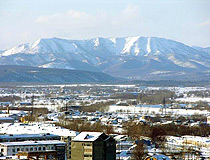
Yuzhno-Sakhalinsk from above
Author: Vladislav Yarowind
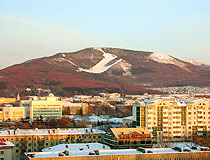
General view of Yuzhno-Sakhalinsk
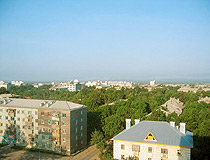
Yuzhno-Sakhalinsk cityscape
Author: Shinya Ichinohe
Yuzhno-Sakhalinsk - Features
Sakhalin Oblast is the only region in Russia located entirely on the islands. Yuzhno-Sakhalinsk stands at some distance from the sea coast, about 25 km from the coast of the Sea of Okhotsk. Chekhov Peak (1,045 m), one of the highest peaks of Sakhalin, rises to the north-east of the city. Locals call the city simply Yuzhnyy.
Sakhalin Island is part of the temperate monsoon zone. Yuzhno-Sakhalinsk is located on a plain surrounded by hills, due to which its climate has certain peculiarities. In summer, it can be very hot in Yuzhno-Sakhalinsk, and in winter, due to the lack of wind, severe frosts. The coldest month is January with an average daily temperature of minus 12.2 degrees Celsius, the warmest month is August with an average daily temperature of plus 17.3 degrees Celsius. Yuzhno-Sakhalinsk is equated to the regions of the Far North.
The city is located in an earthquake-prone area. The probability of strong earthquakes is relatively high. The distance from Yuzhno-Sakhalinsk to Moscow is 9,140 km by road and 6,640 km in a straight line.
The majority of the population is Russian, but the proportion of Koreans is also high (about 20%). Out of 43 thousand Sakhalin Koreans, most of them live in the capital of the region. In the city you can also find representatives of the indigenous peoples: Nivkhs, Ainu and Oroks, but their number is very small.
Yuzhno-Sakhalinsk is the largest transport hub on Sakhalin. Anton Chekhov Yuzhno-Sakhalinsk Airport offers regular flights to such cities as Vladivostok, Krasnoyarsk, Novosibirsk, Khabarovsk, Moscow, Komsomolsk-on-Amur, Petropavlovsk-Kamchatsky, Seoul (South Korea), Sapporo (Japan), Tokyo (Japan).
In Yuzhno-Sakhalinsk, there is a high level of air pollution due to the high motorization of the population and the location of the city in the valley, which slows down the dispersion of harmful substances.
Today, it is one of the dynamically developing cities of the Far East, the production and intellectual center of Sakhalin and the Kuril Islands. Oil and natural gas production, as well as their processing, are the most important components of the local economy.
This is one of the most visited cities in the Far Eastern Federal District of Russia. Yuzhno-Sakhalinsk is often visited by cruise ship passengers (mostly Japanese citizens). Restaurants of Yuzhno-Sakhalinsk offer dishes of Russian, Chinese, Korean, Japanese, Uzbek, Georgian, Italian cuisines.
The architecture of the period of the Karafuto Prefecture gives a special flavor to Yuzhno-Sakhalinsk. Today, in the city there are about 40 objects of cultural heritage of this period. In the future, tourism should become the basis for the economic development of Yuzhno-Sakhalinsk.
Special thanks to Vladislav Yarowind for the photos of Yuzhno-Sakhalinsk.
Main Attractions of Yuzhno-Sakhalinsk
Sakhalin Regional Museum of Local Lore - the central museum of Sakhalin Oblast founded in 1896. It is housed in a very picturesque Japanese building constructed in the Imperial Crown Style in 1937. This is the only such building on the territory of Sakhalin and all of Russia, the most significant architectural monument of Yuzhno-Sakhalinsk. Its diverse expositions are devoted to nature, history of the indigenous peoples of the islands, culture and development of Sakhalin. Kommunisticheskiy Avenue, 29.
Sports and Tourist Complex “Gornyy Vozdukh” (“Mountain Air”) - a ski resort and sports complex, existing, according to one version, since the days of the Japanese Karafuto Prefecture (1905-1945). Today, it is one of the most dynamically developing ski resorts in the Far East of Russia.
The unique location of the complex - in the center of Yuzhno-Sakhalinsk - allows guests to find themselves in the world of winter sports in just a few minutes. The ski resort offers 10 slopes of various difficulty levels for both beginners and professionals. Their total length is over 23 km. The ski season lasts from December to the end of April.
It is one of the main organizers of excursion tours in Sakhalin Oblast: sports, excursion, business tourism, as well as ecological tourism. The complex has a network of hiking and cycling routes. There are also restaurants and cafes here.
Museum and Memorial Complex “Pobeda” (“Victory”) - a square with a cultural and educational center, where you can find historical expositions dedicated to the Russian-Japanese and World War II. A T-34-85 tank is installed on a pedestal in front of the building. Pobedy Avenue, 1.
Museum of the History of the Sakhalin Railway . This museum is dedicated to the history of railway construction on Sakhalin. The exposition has a lot of interesting and rare exhibits. In the open area of the museum, Sakhalin railway equipment is exhibited: steam locomotives, carriages of various types, etc. Vokzalnaya Street, 55.
Sakhalin Regional State Art Museum - the only art museum in Sakhalin Oblast with over 11 thousand works of art. On the ground floor, temporary art exhibitions are held, the art of artists from Russia, Korea and China is presented. The second floor houses permanent exhibitions: “Contemporary Korean Art”, “Christian Art”, “Russian Art of the 19th - early 20th centuries.” Lenina Street, 137.
Museum of the Book of Anton Chekhov “Sakhalin Island” . This museum is dedicated to Anton Chekhov’s trip to Sakhalin in 1890, as a result of which he wrote the book “Sakhalin Island”. Here you can find the following collections: “Painting”, “Graphics”, “Written Sources”, “Photo Materials”, “Numismatics/Phaleristics”, “Household Items, Arts and Crafts”, “Sculpture”. The personal belongings of Chekhov’s family members and various items belonging to exiles are exhibited here. Mira Avenue, 104.
Yuzhno-Sakhalinsk Park of Culture and Rest named after Yuri Gagarin - the most beautiful recreational area of Yuzhno-Sakhalinsk founded in the Japanese period of the city’s history in 1906. In 1968, when the famous cosmonaut Yuri Gagarin died in a jet crash, the park was renamed in his honor. Today, this place attracts visitors with its amazing landscapes and an abundance of entertainment. Sakura blooms here in spring. Detskaya Street, 1.
Resurrection Cathedral - the first church in Yuzhno-Sakhalinsk built in the 1990s. This one-domed cathedral in the pseudo-Russian style looks surprisingly graceful and is located in the immediate vicinity of Gagarin Park. Svyatitelya Innokentiya Boulevard, 3k1.
Cathedral of the Nativity . The height of this church, consecrated in 2016, is 77 m, which is why it effectively dominates the surrounding landscape. Accommodating up to 1,000 people, it is built in the Novgorod style with a gilded dome surrounded by four bright blue ones. Inside, you can admire the five-tiered iconostasis in the Russian style, decorated with 98 icons. The outer walls are decorated with mosaics created in Jerusalem. Ilarion Troitsky Street, 1.
Chekhov Peak . Several picturesque mountain peaks are located in the vicinity of Yuzhno-Sakhalinsk. The highest one (1,045 m) is named after the famous Russian writer Anton Chekhov. The trip to the top takes several hours. From the height of Chekhov Peak you can admire the city itself, the waters of Aniva Bay and the Sea of Okhotsk. On a cloudless day, you can even see the northern tip of the Japanese island of Hokkaido. There is a small Japanese temple at the top of the peak.
Yuzhno-Sakhalinsk city of Russia photos
Architecture of yuzhno-sakhalinsk.
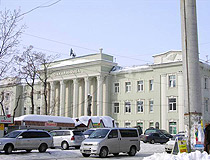
Winter in Yuzhno-Sakhalinsk
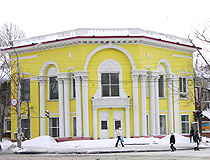
Yuzhno-Sakhalinsk architecture
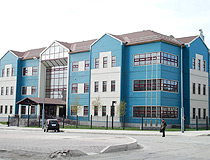
Yuzhno-Sakhalinsk modern architecture
Author: Alexander Mikhalev
Churches of Yuzhno-Sakhalinsk
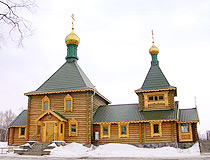
Wooden Church of St. Nicholas in Yuzhno-Sakhalinsk
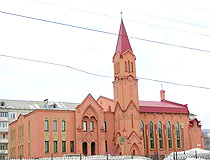
The Roman Catholic Church Parish of Saint James in Yuzhno-Sakhalinsk
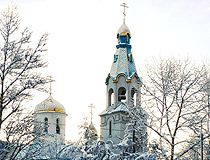
Resurrection Cathedral in Yuzhno-Sakhalinsk
Author: Snejanna Baggerovski
Sakhalin Regional Museum of Local Lore
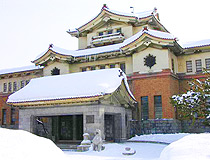
The main building of the Sakhalin Regional Museum of Local Lore
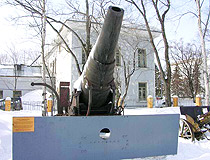
Old Russian 11-inch gun (1867) in Yuzhno-Sakhalinsk
The comments of our visitors
- Currently 3.12/5
Rating: 3.1 /5 (183 votes cast)
- Weather Guides For Every Country In The World
- Algeria: Two Week Journey
- Cairo Travel Guide
- Best Time to Visit Lesotho
- Burkina Faso
- Central African Republic
- Côte d’Ivoire (Ivory Coast)
- Democratic Republic of the Congo
- Equatorial Guinea
- Guinea-Bissau
- Best Time to Visit
- Entry Rules and Visa requirements
- Salt Cathedral of Zipaquirá
- Dominican Republic
- Antigua and Barbuda
- El Salvador
- Afghanistan
- Bahrain Travel Guide
- The Cook Islands
- Aktau, Kazakhstan: Travel Guide and Tips
- Roadtrip in Western Kyrgyzstan
- Journey around Issyk-Kul
- Pakistan travel guide
- Albania Road Trip Guide
- Albania’s Entry Rules
- Yerevan Travel Guide
- Faroe Islands
- Suburbs of Paris
- Batumi Travel Guide
- Tbilisi Raves
- From Mestia to Ushguli (Svaneti) Trekking Route
- Transadjarian Highway
- Peloponesse Road Trip Guide
- Milan Travel Guide
- The Ultimate Venice Guide
- Modern Milanese architecture
- Budva Travel Guide: Montenegro’s main resort
- Montenegro Road Trip Guide
- Transylvania
- Yakutsk Travel Guide
- Journeying Through History: The BAM Railway Experience
- Veliky Ustyug Travel Guide: Meet the Ded Moroz
- Belgrade’s Cultural Guide
- Belgrade Off the Beaten Path
- Road Trip Guide
- Istanbul 🇹🇷: Hand-Painted Signs from a Century Ago
- From Grodno to Brest: a roadtrip
- Bosnia and Herzegovina
- Holy See (Vatican)
- Liechtenstein
Sakhalin: Your Essential Guide to Russia’s Enigmatic Eastern Island
- January 14, 2024
A Journey Through Giant Burdocks, Wild Bears, and the Echoes of Ancient Japanese Temples
From the most dreaded place of exile in the Russian Empire to a Japanese industrial base and one of the most attractive and inaccessible places for domestic tourism in Russia.
Table of Contents
An island that was Russian, then Japanese, and then Russian again
From the 17th to the mid-19th century, it was believed that Sakhalin was a peninsula. This misconception firmly established itself on the maps of the time, as navigators failed to circumnavigate the island. The proximity of Sakhalin’s southern tip to the mainland created a false impression of being impassable for ships. An additional complexity arose from the fact that the route taken by ships from the Russian Empire involved passing through a narrow strait, which Nevelskoy managed to navigate only in 1849.
For a long time, people did not believe Nevelskoy, but he insisted that he had discovered a route through the strait, for which he became something of a hero in Primorye. Monuments and plaques dedicated to him can be found in Yuzhno-Sakhalinsk, Vladivostok, and Khabarovsk. The H4H creative association created a graphic novel based on this story, which won a cultural initiatives contest and became part of the interior of the Khabarovsk Airport. By the way, the Sakhalin region is the only Russian entity entirely located on islands.

The remote and isolated location of the island during the Russian Empire was used as a natural barrier, and it became the site of penal colonies for hard labor prisoners. Its geographical position led to Sakhalin’s hard labor being regarded as particularly cruel.
During the period of the island’s development, Russian ships followed the Amur River and reached the island from the north, where the oldest port, Alexandrovsk, was founded. The Japanese attempted to develop the island from the south, entering through the Kuril Islands (part of the Sakhalin region) and Aniva Bay. For a long time, the Kurils were inhabited by the Ainu, representatives of a small indigenous people. The very word “Kurils” comes from the Ainu: “kuru” means “man.”
In the 17th century, Japan conducted its first expeditions towards the islands and began their development. Russia reached them later. The first mentions of the islands in Russian language date back to the late 17th century. For a long time, Russian, Dutch, Japanese, and Anglo-French navigators studied the islands, landed on them, and disputed their territorial ownership. However, only Russia and Japan managed to establish a foothold. To end the territorial disputes, the governments of the two countries signed an agreement under which the Kuril Islands went to Japan, and Sakhalin to Russia, which continued to develop the island mainly from the north. After the Russo-Japanese War of 1904-1905, which ended in Russia’s defeat, the southern part of Sakhalin became part of Japan as the Karafuto Prefecture.

Until the second half of the 20th century, the island was owned by Japan and was quite successful in developing its resources. A huge number of mines were opened, several cities and lighthouses were built. In particular, the current regional center, Yuzhno-Sakhalinsk, was the former Japanese city of Toyohara. The famous Aniva lighthouse, now considered a symbol of Sakhalin, was built by Japanese engineers. After Japan’s defeat in World War II, the island passed to the Soviet Union. Contrary to history, the main life of the island moved from the north to the south. Alexandrovsk, which was convenient to reach by water, lost to Yuzhno-Sakhalinsk with its infrastructure built by the Japanese, connections to neighboring cities, and airport. Interestingly, before leaving, the Japanese buried and hid the mining sites, and locals say that not all the old mines have been found yet, and they are sometimes stumbled upon during walks.
Because the island belonged to three different countries in just over a hundred years, it did not have time to develop any significant urban infrastructure. The cities lack outstanding architectural monuments and unique museums. However, some unusual Japanese architecture has remained. Meanwhile, Sakhalin compactly houses incredible natural attractions. Here, one can climb through forests and bamboo thickets to breathtakingly beautiful mountains as if outlined in graphite, and through a mountain pass reach the sea, into which clear mountain rivers flow with fish splashing in them.

The Ainu and Nivkh: Inhabitants of Sakhalin
For a long time, the island was mainly inhabited by the Ainu and Nivkh peoples. These ethnic groups are very different, making their coexistence as unusual as the neighboring of birch and bamboo on the slopes of Sakhalin’s mountains. Both are isolate peoples . However, the Ainu belong to the Australoid race, while the Nivkh are Mongoloids (the main population of Asian territories). It’s fascinating how representatives of different races have coexisted for ages on a small piece of land at the edge of the world.
There is no single version regarding the origin of the Ainu, leading to a multitude of theories — both scientific and conspiratorial. One theory suggests that the Ainu are the ancestors of the indigenous population of Australia, remaining in the north after continental migration. Some researchers write that the Ainu are the forebears of the Japanese. This theory is supported by the fact that before Japanese expansion, the Ainu mainly inhabited the Japanese island of Hokkaido. However, the Ainu suffered greatly from Japanese imperialism, and their culture and language were almost completely destroyed in the 19th and early 20th centuries. Now, there are just over two thousand Ainu living on Sakhalin.

The Nivkh are among the indigenous small-numbered peoples of the north. They suffered less from Japanese rule. However, during the Soviet era, they experienced a difficult phase of literacy development, destruction of tribal communities, and relocation to cities. About 2,200 Nivkh live in the Sakhalin region and another approximately two thousand in Khabarovsk.

During the Karafuto period, Japan brought captured Koreans to Sakhalin for hard labor. By the mid-20th century, the Korean population of the island was about 45,000 people. For comparison, the current population of Yuzhno-Sakhalinsk is 180,000. This large number of people, deprived of their homeland, was forced to adapt to life first under Japanese and then Soviet rule. In the USSR, Koreans were issued passports, and there were national kindergartens and schools. However, Sakhalin Koreans did not feel part of the larger community of Soviet Koreans (Koryo-saram) and struggled to integrate. Moreover, they were considered members of an ‘unreliable nation’ because they had lived in the Japanese Empire.

In the late 1990s, three countries – Russia, South Korea, and Japan – began a repatriation campaign for the first generation of Sakhalin Koreans (born before August 15, 1945) to their historical homeland. Now, about 3,500 repatriates from Russia live in South Korea. Under the program, the Korean government provides medical insurance and a monthly allowance to the repatriates. The Japanese government, in turn, buys housing (apartments up to 40 m²) and covers transportation costs. Additionally, every two years, Sakhalin Koreans who have moved to their homeland have the right to visit Sakhalin for free, funded by the Japanese government. Most Sakhalin Koreans settled in the city of Ansan , where 500 apartments were specially built for them.
Korean influence is weakly traced on Sakhalin: many Sakhalin Koreans no longer know the language and do not associate themselves with Korea. However, there are several authentic restaurants (for example, “Koba” ) on the island where you can try traditional dishes.
Yuzhno-Sakhalinsk — the capital and base for exploring the island
The city is predominantly characterized by typical Soviet architecture, with almost no remaining Japanese buildings. This is because during the Soviet period, the city was radically rebuilt after being liberated from ‘imperialist Japanese rule.’ Many buildings were demolished, and from the few that remained, some were turned into museums. Perhaps the main thing that has been preserved from the Japanese period is the layout. The city was founded from scratch near the Russian village of Vladimirovka, and Chicago was chosen as the model for its layout. Toyohara was divided into four parts by two main streets, O-dori (now Lenin) and Maoka-dori (Sakhalinskaya).

Japan established itself thoroughly on the island. In Toyohara, trade routes converged, new bays were developed, and roads were built. The city’s population grew steadily. Initially due to the military garrison, and later due to a paper mill, a sugar and distillery plant. Now, the buildings of the former Japanese factories are abandoned. Many of them can only be accessed with rare tours, while others are completely closed. However, their presence is still recalled by street names, such as Paper Street.

Another building in the Neo-Japanese style is the Karafuto Governorate Museum built in the 1930s (29 Communist Avenue). It now houses the Sakhalin Regional Museum . And in the former bank of colonial development, there is the Art Museum (137 Lenin Street).

Several other iconic buildings constructed by the Japanese have been preserved: the central hospital of Toyohara (41 Chekhov Street), the conference hall of the Karafuto Governorate (30 Dzerzhinsky Street), and the Toyohara City Hall (41 Communist Avenue). The Sakhalin Railway Museum in Yuzhno-Sakhalinsk is distinct from many similar museums in Russia due to its exhibits. This is because the island long maintained the Japanese standard of railway gauge, which differs from the Russian standard. Accordingly, the rolling stock was entirely different.
If in Vladivostok everything is named after the Far Eastern explorer and writer Vladimir Arsenyev, then in Yuzhno-Sakhalinsk, mentions of Chekhov are everywhere. At the end of the 19th century, Sakhalin was both the most dreaded place for exile to hard labor and one of the most tempting corners of Russia, which was not so easy to access. Chekhov received an editorial assignment and embarked on a ship along with prisoners, military personnel, and sailors to the most remote point of the empire. In his notes, which Chekhov compiled under the title ‘The Island of Sakhalin,’ the writer talked about many things: the geography and climate of the island, the life of the convicts, and ordinary residents. This book caused a great resonance at the time, and even now it was very interesting to read it while traveling to Sakhalin: some things have changed drastically, while others have remained the same. Now in Yuzhno-Sakhalinsk, there is even a museum dedicated to this one book, which turned out to be so significant for the island.
GoSakhalin is the website of the Sakhalin Tourist and Information Center. And in their official Telegram channel , you can find announcements of affordable excursions shortly before they start.
In any case, for travelers, Yuzhno-Sakhalinsk remains primarily a hub and a place of rest. Here they return for the night and dinner, and it seems that real adventures begin outside the doorstep.
Surrounding Area
10–20 kilometers from Yuzhno-Sakhalinsk
The main reason people visit Sakhalin is for its unique nature. Mountains, forests, rivers, lakes, and the sea, all on a small piece of land. In one day, you can travel from the Sea of Okhotsk to the Sea of Japan, cross several climate zones, see bamboo groves, birches, and spruces in one place, spot a running fox and a swimming orca. The island’s landscapes can boldly compete in Instagram appeal with Iceland or Norway.
Within Yuzhno-Sakhalinsk alone, there are about 30 kilometers of marked ecotrails, with brief descriptions and routes available on the official tourism portal. I also found an ecotrail in Nevelsk, which is not mentioned on the official website.
The ecotrails in Yuzhno-Sakhalinsk start from the ‘Mountain Air’ ski center on the sopka (a term for mountains in the Far East) Bolshevik. There are five in total: ‘Children’s’ (2.7 kilometers), ‘Eight’ (8 kilometers), ‘Northern Ring’ (9 kilometers), ‘Russian’ (3.2 kilometers), and ‘Yelanka’ (5 kilometers). You can take a cable car to the start of the trails and then slowly descend through the forest and park to the city. However, the lift does not operate in rainy and windy weather.

Hiking the ‘Eight’ trail took me no more than three hours, including stops to catch my breath and take photos. Every kilometer and a half along the route, there are benches. From the top of the mountain, there is a view of Yuzhno-Sakhalinsk, and it seems you can see a piece of the Sea of Okhotsk.

Chekhov Peak
The route to Chekhov Peak is a high-mountain trekking path that requires a certain level of physical fitness. Chekhov Peak has an elevation of 1045 meters, with an absolute altitude gain of 752 meters. The trail is narrow and slippery in places, hardly suitable for children or people with limited mobility.

Chekhov Peak is part of the Susunai Range, which supports Yuzhno-Sakhalinsk from the southeast. You can exit from Gagarin city park to the foothills in about half an hour. The ascent to the peak itself cannot be missed: a marked trail and informational signs lead to it. On particularly steep ascents, ropes are hung for safety, but it is possible to walk up the slope without them.
In late spring, the forest trail has many streams, as well as May primroses and butterflies. The foothills are scattered with rare, incredibly large, and wonderfully fragrant marsh callas. Halfway to the peak, bamboo thickets are encountered, through which birches break through. This is also a kind of magic because, as a biologist friend explained to me, birch and bamboo are not supposed to coexist in the natural environment, but somehow they manage to do so. Occasionally, spruces are encountered — not tall, but very fluffy. Closer to the top, the vegetation becomes sparser, and the impressive views of the sea, mountains, and lakes open up from the height.

- The entire hike takes five to six hours.
- Even in summer, there is snow on the summit. In the afternoon, it starts to melt, making it more difficult to walk.
- Don’t forget to bring food and water.
- Wear boots with covered ankles, a jacket, and a head covering.
- Inform your family and friends, and someone living in Sakhalin, before setting out on the route. If you’re traveling alone, you could notify, for example, the hotel receptionist or roommates in a hostel.
- Snakes and bears are found around the trail. Watch your feet and try to make as much noise as possible. For example, play music on your phone and sing along occasionally.
- The ascent to Chekhov Peak can be the start of a journey to the village of Lesnoye on the shore of the Sea of Okhotsk. The distance to the village is 27 kilometers. With good preparation and an early start from Yuzhno-Sakhalinsk, this distance can be covered in one day.

Mud Volcano in Klyuchi
A mud volcano is an eruption on the earth’s surface of clay masses, mineralized waters, and gases. The mechanism of formation of these volcanoes is not fully understood. According to the existing theory, such volcanoes are formed near oil fields.
The mud volcano in Klyuchi consists of a mud field about 200 meters in diameter. There, you can see about 20 points of activity, resembling miniature volcano craters. This mud volcano became active in 1959, 1979, 2001, and 2011 (the last time due to a strong earthquake in Japan). During these eruptions, mud columns reached several tens of meters in height. Bus 189 goes to Klyuchi from Yuzhno-Sakhalinsk. The distance from the village to the top of the volcano is nine kilometers and takes about two and a half hours to walk.

Ecopark in the Vestochka area: Frog Rock, Aikhor Waterfall, ‘Sunny Glade’ Recreation Park
Not far from Yuzhno-Sakhalinsk, there is a fairly large ecopark, known primarily for the Frog Rock outcrop. An outcrop is a remnant of harder rock around which softer rock has eroded over time. Outcrops are often known for their unusual shapes and are natural monuments. Frog Rock is part of a series of rocks standing one behind the other. This was once the seabed of an ancient sea, and fossilized shells can be found in its vicinity. From the top of the rock, amazing views of the Aniva Bay, Tunaycha and Changeable Lakes open up. This place was sacred to the Ainu, the indigenous inhabitants of the island.

The trail to the ‘Sunny Glade’ ecopark begins behind the ‘Electron’ culture house. Despite its name, it is not a city park, but a full-fledged forest with laid-out paths. There are houses, glades with tables for rest where you can cook barbecues, and wooden walkways leading to various attractions. These are all paid services.

The path to Frog Rock outcrop goes along the Komissarovka River. In areas of spring flooding, callas bloom and bamboo grows. The outcrop is located on a hill, with a total elevation gain of about 300 meters. The road is quite challenging, usually taking from an hour to an hour and a half. The higher you climb, the more you can see: the sea, the mountain gorge, the road to Vestochka. In the same park is the Aikhor Waterfall, which is also a short climb away, but along a less well-maintained trail. You can plan a whole day to visit Vestochka and even spend the night, without returning to Yuzhno-Sakhalinsk.

Vestochka is three high-rise buildings on one side of the road and a cottage settlement on the other. It is part of Yuzhno-Sakhalinsk, though located 15 kilometers from the main part of the city. A taxi there costs about 1000 rubles and takes 40 minutes. About a kilometer after turning off the main road, the asphalt ends and a terribly dusty dirt road begins. If you’re lucky, you can catch a bus that runs three times a day.
What else to see on the island
40 kilometers from Yuzhno-Sakhalinsk
The oldest city in the south of Sakhalin, founded by Nevelskoy’s expedition. Here you can find a huge number of monuments dedicated to sailors, naval battles, and ships. The most significant monument in the city in recent decades has become the stele dedicated to ‘Koreans interned by the Japanese in Sakhalin, who never returned to their homeland,’ located on Mount Sorrow, created through the efforts of three countries’ governments (Russia, Japan, and Korea).

In Korsakov, some Japanese heritage has been preserved: the former building of the Hokkaido Takushoku Bank, a colonial development bank (Sovetskaya Street, 3), trade warehouses in the port, a document storage facility ‘Bunsyoko’ (Krasnoflotskaya Street, 1), a couple of rusty fire hydrants, and remnants of Shinto temples in the form of pillars with hieroglyphs. One of the local nighttime entertainments is watching the lights of the gas processing plant.
How to get there. Three electric trains a day, the journey takes just over an hour, and the ticket costs 75 rubles (0.74 euros).

Bird and Giant Capes
90 kilometers from Yuzhno-Sakhalinsk
Two capes, recognized as natural monuments in 1990, along whose coasts are many wind and wave-carved grottoes, caves, arches, and columns of various sizes and whimsical shapes, among which colonies of sea birds reside.
The place is not very close, but it’s very picturesque at any time of the year. In the area of one of the rocks, there is a pool where, during the salmon spawning period, you can observe a fascinating spectacle — a huge gathering of pink salmon.
Many tourists stay on the coast overnight to witness the sunset and sunrise. Near Cape Giant, there is a toilet, parking, and a rest area with benches.
How to get there. The journey from Yuzhno-Sakhalinsk goes through the village of Okhotskoe, where you can buy fresh crabs, and takes about three hours one way. The road is fully passable only by high vehicles like Mitsubishi Pajero, Suzuki Jimny, as the last ten kilometers of the route have deep puddles, potholes, small cliffs, and rivers.

Nevelsk and Steller Sea Lions
Nevelsk is nestled between mountains and sea. The rocky mountains and the coast, which consists of small stone needles and shells, in every way explain why Chekhov so often mentioned in ‘The Island of Sakhalin’ how harsh the land of Sakhalin is.

Steller sea lions are the largest of the eared seals. One of their habitats is the breakwater in Nevelsk. As soon as you arrive in the town, the smell from the Steller sea lions’ haul-out site hits you. ‘They eat there, live, give birth to their young – that’s why it smells,’ the locals explain. Another feature is the noise. Steller sea lions are very loud!
You can view the sea lions from the central square, where binoculars are installed. However, tourists usually hire a boat and approach the haul-out site to get a closer look at the seals. You can see how the Steller sea lions bark, lie in the sun, jump into the sea and, most interestingly, try to jump back. The views from the square through binoculars are not as detailed and impressive. A place on the boat will cost 1000–1500 rubles (9.81 – (14.71 euros). You can also buy a tour from Yuzhno-Sakhalinsk for 3500 rubles (34.33 euros). The most animals are present in spring and early summer. In autumn, there may be a couple of dozen individuals left.

From the embankment, you can observe the huge kelp laminaria floating in the sea. Some travelers catch them themselves and eat them. Although dishes made from seaweed are found in cafes and also sold in stores. Signs are installed on the shore indicating where to run in case of a tsunami. The last major earthquake with waves was recorded in 2007. Many houses were destroyed and two people died. The most famous Sakhalin tsunami was the 1952 tragedy , when the aftermath of the earthquake almost completely destroyed Severo-Kurilsk.
How to get there. From the bus station (Karl Marx Street, 51b) in Yuzhno-Sakhalinsk, buses go to Nevelsk, the ticket costs 300 rubles (2.94 euros), and the journey takes about an hour. Tickets can be purchased at the bus station ticket office or from the driver (cash or transfer). It’s not possible to board the bus somewhere in the city, as the bus does not make stops. It’s better to buy a return ticket immediately upon arrival in Nevelsk at the Nevelsk bus station ticket office (Lenina Street, 1). The bus is popular with locals, and there may simply be no seats left.
Remnants of structures from the Karafuto period include the Maoka-Jinja temple with a Japanese-style garden and an abandoned railway built by the Japanese. It used to connect Kholmsk with Yuzhno-Sakhalinsk. Tourists usually come to see two photogenic bridges – Devil’s and Witch’s – and a tunnel in the mountain that makes a full circle inside it. The trail passes along the old rails, and there are many vipers, so one needs to watch their step.
How to get there. The bus to Kholmsk takes two hours, the ticket costs 450 rubles (4.41 euros), with 14 trips a day.

Slepikovsky Cape and Lighthouse
120 kilometers from Yuzhno-Sakhalinsk
At Slepikovsky Cape, there is the only relic grove of Korean cedar on Sakhalin. Also located here is the functioning Slepikovsky Lighthouse, which is a 27-meter tall round tower, connected by corridors to utility and residential buildings.

The cape and lighthouse are named after the commander of the Russian partisan detachment Bronislav Grotto-Slepikovsky, who operated in Southern Sakhalin during the 1904–1905 war. The route to the lighthouse goes through the villages of Yablochnoe and Sadovniki, where some of the best beaches on Sakhalin are located — with the cleanest water and white sand.
How to get there. The cape is located 29 kilometers north of Kholmsk. From Kholmsk to the turn towards the lighthouse, there is asphalt with dirt sections. From the turn to the lighthouse, there is first a dirt road, then beach sand, which is recommended to be driven on with deflated tires. Visiting time is from spring to autumn, as the road to the cape is not cleared in winter.
110 kilometers from Yuzhno-Sakhalinsk
In 1891, when the island had a penal colony, this was the Russian village of Siraroko, named after a nearby Ainu settlement. In 1905, the south of Sakhalin was given to the Japanese, and the village was renamed Higashi Shiraura. Here there were a railway station, a brick factory, and a coal mine. 40 years later, the settlement was renamed Vzmorye.
During the Japanese times, there was the Shinto shrine Higashi Shiraura Inari-Jinja. Only the torii gates remain — P-shaped gates without doors that are placed on the path to a Shinto shrine. These are the only torii on Sakhalin. On the torii, there is an inscription ‘In honor of the 2600th anniversary of the foundation of Great Japan’ — this mythological date was widely celebrated in 1940.

On the way to the torii, you can see the famous giant burdocks and bear’s garlic. Vzmorye is also known as a place where poached crabs are sold along the highway.
How to get there. Two electric trains and one train that start from Yuzhno-Sakhalinsk stop in Vzmorye. Unfortunately, all three are in the evening. You can also get there on passing buses that go to the north of the island.
Tikhaya Bay
140 kilometers from Yuzhno-Sakhalinsk
On one side, the bay is framed by Mount Smely, and on the other side, the majestic Zhdanko Ridge begins. To the left in the bay itself is an island-kekur, which can be reached during low tide, as well as the epic cliffs of Tikhaya Cape. By the way, behind this cape, there are waterfalls that become icefalls in winter. At the base of the bay is the mouth of the Tikhaya River, where during the season you can see the spawning of pink salmon and chum salmon. Bears are aware of this, so they are often encountered here.
How to get there. Buses going to Poronaysk stop in the village of Tikhoye, near which the bay is located. There are four trips a day.

Aniva Lighthouse

The lighthouse has a complex history: there were attempts to maintain it under Soviet rule, but Aniva was so remote from inhabited areas that it was not profitable. Eventually, the lighthouse was switched to autonomous mode, bringing in a radioactive isotope to sustain its operation, and then it was completely closed. To this day, you can find signs on the walls reading ‘Caution, radioactive’. But now this warning is outdated, as the radioactive isotope was removed when the lighthouse was decommissioned. The lighthouse is very beautiful, offering views of the island and sea, and inside you can explore the remnants of rooms and working areas.

On the return trip, tourists are also taken to Mramornaya Bay, where you can also climb a mountain and view the jagged coast of Sakhalin from above. Orcas and whales are often encountered in these areas, most frequently in summer. I would also recommend taking a combined tour in summer to Aniva Lighthouse, the Blue Lakes, and Busse Lagoon, where you can see the amazingly blue waters and try sea urchins.

A kilometer from Novikov is Cape Tri Kamnya (46.320342 143.373006), which can even be reached by car. Four kilometers from the cape is the small Strelka waterfall , which requires a walk. If you stay in the village overnight, you can take a hike to the Blue (turquoise) Lakes (46.359603, 143.471909). On the way, there’s an abandoned Japanese power station. You can extend your route by another 15 kilometers and reach the opposite shore of the peninsula – to Cape Evstafiya. The road from Novikov to Cape Evstafyeva through the Blue Lakes can be driven in a jeep, if there hasn’t been prolonged rain before. But it’s better to ask in advance those who have recently been there, and get the phone number of a local tractor driver in Novikov, so that if something happens, he can pull you out.

How to get there. Getting there independently is almost impossible. The lighthouse is located on a rocky outcrop in the sea, and the nearest land is a high cliff. However, some people do reach Novikovo (the nearest village) by bus or car, and then walk 44 kilometers on foot to Aniva (the name of both the lighthouse and the bay). It takes about one and a half hours to drive from Yuzhno-Sakhalinsk to Novikovo. And then another two hours of rough dirt road to the boat dock. A tour from the company ‘Friends-Hikers’ costs 6000 rubles (58.84 euros) in May (in summer – 7000 rubles (68.65 euros)).
Klokovsky Waterfall
190 kilometers from Yuzhno-Sakhalinsk
Klokovsky Waterfall is one of the highest waterfalls on Sakhalin Island. Its height is variously reported to be 48–49 meters, with a width of up to nine meters. The waterfall is accessible year-round, but is most full in late spring and early summer.

Alexandrovsk-Sakhalinsky

The ‘Tri Brata’ (Three Brothers) rocks are definitely a symbol of Alexandrovsk-Sakhalinsky, and perhaps of the entire island. They are located in the Alexandrovsk Gulf almost opposite Cape Zhonkiyor. From the cape, there is a stunning view of the vast Tatar Strait and the Three Brothers. At low tide, it’s possible to calmly explore all the attractions of the gulf, collect seaweed and shells, see hermit crabs scuttling along the seabed with their shells on their backs, or watch the leaves of laminaria sway. At the strongest low tide, you can even walk to the Three Brothers through the water.

In the 19th century, convicts carved a 90-meter tunnel through Cape Zhonkiyor to service the lighthouse. To reach the tunnel by land, you need to come at low tide. Otherwise, you’ll have to climb the rocks. The tunnel is lined with logs, but there is almost always water at the bottom and a strong wind howls through it. If you pass through the tunnel, you will see the ‘Tri Sestry’ (Three Sisters) rocks and an old lighthouse from the end of the 19th century. All these places are described by Chekhov in ‘The Island of Sakhalin’: ‘Most often we went to the lighthouse, which stands high above the valley, on Cape Zhonkiyor. During the day, the lighthouse, if looked at from below, is a modest white house with a mast and lantern, but at night it shines brightly in the darkness, and then it seems that the penal colony looks at the world with its red eye. The road to the house climbs steeply, winding around the mountain, past old larches and firs. The higher you climb, the freer you breathe; the sea spreads before your eyes, thoughts gradually come, having nothing to do with the prison, the penal colony, or the exile settlement, and only then do you realize how dull and difficult life is down below.’
How to get there. From Yuzhno-Sakhalinsk, there is one bus trip per day – at 12:10. The ticket costs 2200 rubles (21.58 euros), and the journey takes nine hours.

600 kilometers from Yuzhno-Sakhalinsk
The main transit point on the way to the oil refineries. The village might be of interest to those curious to see a harsh northern town living off production: low-rise buildings made of siding and unexpectedly bright murals on the walls of five-story buildings. There is a local history museum in the village (Sovetskaya Street, 3) – it is praised for its excellent exhibition of the Nivkh culture and a monument to Nevelskoy. Also, one of the longest rivers of Sakhalin, the Tym (which translates from Nivkh as ‘spawning river’), flows through the town.
How to get there. A night train goes to Nogliki every day, taking almost 12 hours. The cheapest ticket in a seated carriage costs 1100 rubles (10.79 euros), a compartment – 4100 (40.21 euros). There is even a luxury (SV) carriage for 12600 rubles (123.57 euros).
Where to Stay
Hostels in the Far East are divided into work and tourist types. The former will also accommodate tourists, but the atmosphere there is like a dormitory where their own rules are already established, and you may feel like an uninvited guest. To avoid such a hostel, it’s important to carefully read the reviews, not book the cheapest hostels, not stay on the outskirts or near airports and train stations.
In the Islander hostel , mainly travelers stay, it’s very cozy, with convenient kitchen and showers with toilets. A double room costs 3000 rubles per day, and dorms – from 900 rubles (8.83 euros) per night. If you book directly through the website and for a long term, you can get a good discount.
The ‘Moneron’ hotel is located near the railway and bus stations. It’s a classic budget hotel with small clean rooms. The ‘comfort’ class rooms have a bath, and the hotel provides a complete set with slippers, towels, and a hairdryer. Prices start from 2800 rubles (27.46 euros) per night for a single economy room, while ‘comfort’ costs 4900 rubles (48.06 euros). Breakfast is included in the price.
The ‘Belka’ hotel building is made using Finnish technology in a wooden style from milled timber. The cost of large rooms with wooden walls and huge beds starts from 5800 rubles (56.88 euros). Breakfast is also included in the price. The hotel complex includes a sauna, spa, tavern, and gym.
Near Bussé Bay is the island’s only dome-shaped glamping site. A night for two costs 8000-10,000 rubles (78.46 – 98.07 euros). An extra bed is 2000 (19.61 euros). Each dome has a shower, toilet, and electricity. On cooler days, you can light the stove and sit by the fire with a cup of hot cocoa.

In other towns, apart from Yuzhno-Sakhalinsk, the choice of hotels is quite modest and usually limited to one or two hotels, which cannot always be booked online. They have to be found on the map and booked by phone.
Transport on the Island
Car. If you’re only traveling between cities, there won’t be any problems – the roads between them are mostly paved, and the dirt roads are of more or less good quality. It gets more complicated with natural attractions. Almost all of them are accessed by dirt roads, which not every car can navigate.
In Yuzhno-Sakhalinsk, ‘Yandex.Taxi’ and ‘Maxim’ operate (also in Korsakov and Kholmsk). A trip within the city limits will cost a maximum of 300 rubles (2.94 euros).

Railway. From Yuzhno-Sakhalinsk, about 30 electric trains depart daily. Most of them go to nearby areas like Dalnyaya, Khristoforovka, and Novoaleksandrovka stations – 8–23 minutes travel time.
To other cities, there’s only one electric train per day. It takes an hour to Korsakov and the ticket costs 80 rubles (0.78 euro). To Tomari, it’s four hours and 300 rubles (2.94 euros). To Poronaysk, it’s five hours of travel and 500 rubles (4.90 euros) for a ticket. Long-distance electric trains depart in the evening, as these routes are used by residents of the province who return from work in Yuzhno-Sakhalinsk to their homes.
There is also one train on the island – Yuzhno-Sakhalinsk to Nogliki, 12 hours of travel and 1100 rubles (10.79 euros) for a ticket in a sitting carriage.

Buses. It seems you can reach even the most remote settlements by bus. Often there’s only one trip per day, but at least it exists. To Kholmsk, Nevelsk, and Korsakov, the journey takes about an hour and a half, with tickets costing around 300 rubles (2.94 euros); to Poronaysk and Uglegorsk, it’s four to five hours and 1200 rubles (11.77 euros) for a ticket. You can check the current schedule on avtovokzaly.ru . But it’s always better to double-check by phone: +7 (4242) 72-25-53. The address of the bus station is Karl Marx Street, 51b.
Airplane. Sakhalin has a quite extensive network of airports, and you can fly from Yuzhno-Sakhalinsk to Okha, Zonalnoye, Shakhtyorsk, Poronaysk, Smirnykh, Yuzhno-Kurilsk, and Iturup. Flights are operated by the Far Eastern airlines ‘Aurora’ and ‘Taiga’ . These routes are served by small propeller planes Bombardier and Mi-8 helicopters. Such a flight is an interesting experience in itself. Moreover, some flights are quite inexpensive. For example, to Zonalnoye, Shakhtyorsk, and Poronaysk, tickets cost 2000–3000 rubles (19.61 – 29.42 euros) one way. To Okha and the Kurils – from 6000 rubles (58.84 euros).
Ferry. From Korsakov, ferries run to different settlements in the Kurils every three to four days. The ferry to Kurilsk takes about 22 hours, to Yuzhno-Kurilsk – 22–30 hours, and to Malokurilskoye – about 40 hours. Interestingly, a ticket to any of these settlements costs from 2800 rubles (27.46 euros), available on the website of the ferry company.
How to get there
By plain. To travel to Yuzhno-Sakhalinsk from Europe, passengers typically fly through major transit hubs. Common routes involve flying from a European city to one of the major Russian airports offering direct flights to Yuzhno-Sakhalinsk, such as Moscow’s Sheremetyevo or Domodedovo airports. In 2023 it is only possible to fly to Moscow from major transit hubs such as Istanbul or Erevan. From there, travelers can catch one of the direct flights to the island. Some routes might also include stops or transfers in other large cities in Russia or Asia, depending on the airline and the flight itinerary, for instance, Novosibirsk, Krasnoyarsk, Irkutsk, Ulan-Ude, Chita, Blagoveshchensk, Vladivostok, Khabarovsk, Komsomolsk-on-Amur, Sovetskaya Gavan, and Petropavlovsk-Kamchatsky. There is even one international flight from Harbin, China.
In good weather, on approach to Yuzhno-Sakhalinsk, you can see the Tatar Strait, the Western Ridge, and the city itself. The airport is located within the city limits, and from there, you can easily reach any point by public transport (buses 63 and 3) or taxi.

Ferry. Vanino (Khabarovsk Krai) to Kholmsk (Sakhalin) . Passenger tickets for the ferry are sold at the Vanino railway station or at the ticket office in Kholmsk (Lenin Square, 5). They can also be reserved by phone: +7 (42137) 74088 (Vanino), +7 (42433) 50880 (Kholmsk). The ferries run daily, with a journey time of 18–20 hours. A seat costs 650 rubles (6.37 euros), while the cheapest cabin spot is 1400 rubles (13.73 euros). There is a dining room on board.
I was on the island in early May, and this has its pros and cons. On one hand, it’s already not very cold in Sakhalin at this time, and you can walk around in a light jacket or sweatshirt, and sometimes even just in a T-shirt. At the end of spring, you can catch the largest number of Steller sea lions in Nevelsk (closer to summer they migrate towards Avacha Bay). Also at this time, you can see the forest awakening: streams penetrate it from all sides, in their floodplains swamp callas bloom, meadows fill with primroses, and the hills are covered with bright green bamboo shoots. On the other hand, there is still snow in the mountains, in which you can get stuck while climbing, and the sea, which is not very warm in these areas, is completely unsuitable for swimming.
In summer, Sakhalin is not very hot, the coast blooms with wild roses, the sea warms up a bit, and there is less chance of bad weather when visiting remote attractions. Also, it’s precisely at this time you can see orcas (June – July) and whales (July – August), as well as the salmon spawning.
In winter, snowboarders and skiers come to Sakhalin. The mountains on the island are not high, so they are suitable even for beginners.

Related posts:
- The Vertical Grain Elevator (Silo) in Samara — A Benchmark of Brutalist Architecture
- Kamchatka: “Island” of Volcanoes, Bears, and Red Caviar
- Yekaterinburg: A Comprehensive Guide to the Ever-Young and Protest-Ridden City
- Altai Republic (Russia) Travel Guide: A Journey through Twisting Mountain Roads
Leave a Reply Cancel reply
Your email address will not be published. Required fields are marked *
Save my name, email, and website in this browser for the next time I comment.

COMMENTS
Trimaran: Load-aware scheduling plugins # Trimaran is a collection of load-aware scheduler plugins described in Trimaran: Real Load Aware Scheduling. Currently, the collection consists of the following plugins. TargetLoadPacking: Implements a packing policy up to a configured CPU utilization, then switches to a spreading policy among the hot nodes.
Trimaran is a collection of load-aware scheduler plugins described in Trimaran: Real Load Aware Scheduling. Currently, the collection consists of the following plugins. TargetLoadPacking: Implements a packing policy up to a configured CPU utilization, then switches to a spreading policy among the hot nodes.
Trimaran Scheduler. As of Kubernetes 1.15, the scheduler has been made flexible for customizations with the Scheduling Framework. Our team at PayPal leveraged this to develop the Trimaran ...
KEP - Trimaran: Real Load Aware Scheduling # Table of Contents # Summary Motivation Goals Non-Goals Proposal User Stories Story 1 Story 2 Notes/Constraints/Caveats Risks and Mitigations Design Details Metrics Provider Load Watcher/Load Analyser DB Scheduler Plugins TargetLoadPacking Plugin Score plugin LoadVariationRiskBalancing Plugin Score plugin Bad Metrics Load Watcher API Scheduled Pods ...
With the Trimaran scheduler plug-ins, users can achieve basic load-aware scheduling that is not implemented in the default Kubernetes scheduler. Trimaran plug-ins can either balance the usage on nodes so that all nodes reach a certain percentage of utilization, or it can prioritize nodes that have lower risk when overcommitting the pods. ...
Trimaran is a collection of load-aware scheduler plugins described in Trimaran: Real Load Aware Scheduling. \n. Currently, the collection consists of the following plugins. \n \n; TargetLoadPacking: Implements a packing policy up to a configured CPU utilization, then switches to a spreading policy among the hot nodes. (Supports CPU resource.)
Trimaran is a collection of load-aware scheduler plugins described in Trimaran: Real Load Aware Scheduling. Currently, the collection consists of the following plugins. TargetLoadPacking: Implements a packing policy up to a configured CPU utilization, then switches to a spreading policy among the hot nodes. (Supports CPU resource.)
In this talk, we will provide an overview of the Trimaran scheduler plugins and demonstrate their utility. Basically, Trimaran plugins are load-aware schedulers which place pods on nodes based on actual measured node resource utilization, while considering requests and limits specifications of resources. Having utilization as an objective helps ...
Trimaran: Load-aware scheduling plugins. Trimaran is a collection of load-aware scheduler plugins described in Trimaran: Real Load Aware Scheduling. Currently, the collection consists of the following plugins. TargetLoadPacking: Implements a packing policy up to a configured CPU utilization, then switches to a spreading policy among the hot nodes.
Don't miss out! Join us at our next event: KubeCon + CloudNativeCon Europe 2022 in Valencia, Spain from May 17-20. Learn more at https://kubecon.io The confe...
Explore the Trimaran scheduler plugins in this 32-minute conference talk from the Cloud Native Computing Foundation (CNCF). Learn how load-aware scheduling can optimize cluster performance, minimize power consumption, and enhance stability. Discover solutions for common issues like node congestion, utilization spikes, and uneven pod bursting.
Trimaran is a collection of load-aware scheduler plugins described in Trimaran: Real Load Aware Scheduling. Currently, the collection consists of the following plugins. TargetLoadPacking: Implements a packing policy up to a configured CPU utilization, then switches to a spreading policy among the hot nodes. (Supports CPU resource.)
Trimaran: Load-aware scheduling plugins. Trimaran is a collection of load-aware scheduler plugins described in Trimaran: Real Load Aware Scheduling. Currently, the collection consists of the following plugins. TargetLoadPacking: Implements a packing policy up to a configured CPU utilization, then switches to a spreading policy among the hot nodes.
Then click Create to install a secondary scheduler instance that runs the Trimaran scheduler. Finally, the operator will install a secondary-scheduler deployment running under openshift-secondary-scheduler-operator namespace. Check the logs to verify if the Trimaran scheduler is successfully running. apiVersion: kubescheduler.config.k8s.io/v1beta1
Trimaran Tutorial 181 Acyclic Scheduling Schedulers for superblocks or hyperblocks •Cycle scheduler - Generates a schedule by building instructions for each issue cycle in order - Supports cache miss sensitive scheduling if cache miss profile information is available - Supports use-of data speculative loads (LDS/LDV pair) if
How to install the Secondary Scheduler Operator and deploy the loadaware Trimaran scheduler image There is a separation of responsibility when a customer installs their own scheduler via this operator. Customers are responsible for maintaining their custom scheduler and Red Hat is responsible for the operator. This example uses the loadaware Trimaran scheduler image, which Red Hat does not support
The Trimaran scheduler supports meld scheduling and a variety of scheduling algorithms, including back-tracking. Santosh also developed a module to utilize memory dependence profiling information. Within Elcor, Santosh designed a module that reduces cache stalls by increasing the scheduling distance between loads that are likely to miss and ...
The Kingsville is a 422-foot aluminum-hull trimaran that is designed to operate in shallow, near-shore waters, primarily to identify and neutralize mines and to conduct maritime security ...
The below compatibility matrix shows the k8s client package (client-go, apimachinery, etc) versions that the scheduler-plugins are compiled with.
The U.S. Navy commissioned Independence-variant littoral combat ship USS Kingsville -- LCS 36 -- at the Solomon P. Ortiz Center in Corpus Christi, Texas, on Saturday.
Sakhalin Oblast - Overview. Sakhalin Oblast is one of the easternmost regions of Russia and the only region completely located on islands (Sakhalin Island and the Kuril Islands), part of the Far Eastern Federal District. Yuzhno-Sakhalinsk is the capital city of the region. The population of Sakhalin Oblast is about 484,200 (2022), the area - 87,101 sq. km.
Yuzhno-Sakhalinsk began as a small Russian settlement called Vladimirovka, founded by convicts in 1882. [2] The Treaty of Portsmouth in 1905, which brought an end to the Russo-Japanese War of 1904-1905, awarded the southern half of the Sakhalin Island to Japan.Vladimirovka was renamed Toyohara (meaning "bountiful plain"), and was the prefect capital of the Japanese Karafuto Prefecture.
Yuzhno-Sakhalinsk - Overview. Yuzhno-Sakhalinsk is a city located in the southern part of Sakhalin Island in the Far East of Russia, the administrative center of Sakhalin Oblast. The population of Yuzhno-Sakhalinsk is about 201,700 (2022), the area - 164 sq. km. The phone code - +7 4242, the postal codes - 693000-693904.
An island that was Russian, then Japanese, and then Russian again. From the 17th to the mid-19th century, it was believed that Sakhalin was a peninsula. This misconception firmly established itself on the maps of the time, as navigators failed to circumnavigate the island. The proximity of Sakhalin's southern tip to the mainland created a ...